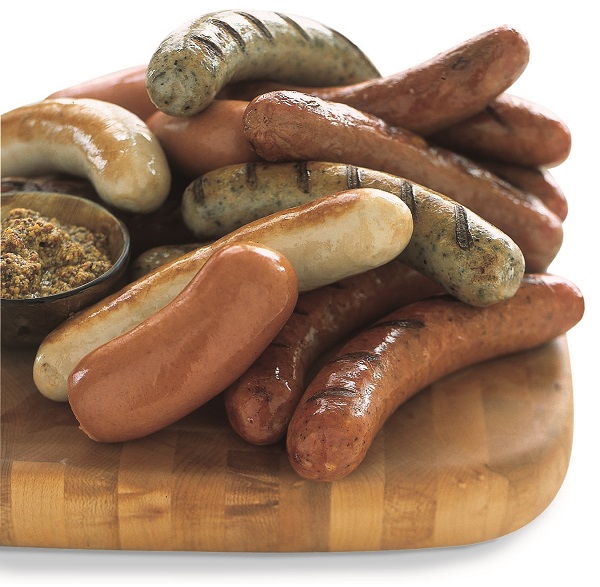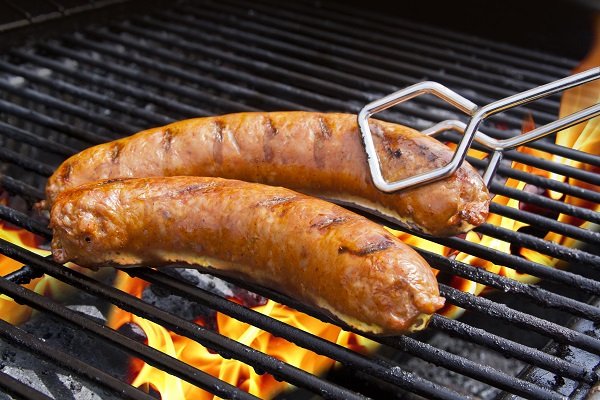While the concept of sausage is simple, thousands of variations can be found throughout the world. Sausages can be fresh, cured, smoked, or cooked. They are made of beef, pork, veal, chicken, and more. And they can include myriad ingredients, from spices and herbs to fruits, vegetables, and cheeses—and even liquids such as beer, whiskey, or blood. Our “Sausage in Profile” series aims to introduce you to different types of sausage—their flavor profiles, histories, and uses—from familiar favorites to unique finds.
Here in the U.S., the name kielbasa refers to a specific type of Polish sausage, but in Polish “kielbasa” is just the general word for “a sausage.” There are many varieties of Polish sausage, as sausage is a staple in Polish cuisine. The sausage Americans are thinking of when they refer to Kielbasa is “Polska Kielbasa Wędzona,” or Smoked Polish Sausage. While each manufacturer of this sausage has its own recipe, this sausage is generally known to contain pork, beef, garlic, marjoram, and spices.

Get it while it’s hot! (Or cold.)
Most Polish sausages are either classified as a “normal” or a dry sausage. Dry sausages are usually consumed cold, while “normal” sausages can be cooked in a variety of ways, but can also be enjoyed cold. Polish sausages also differ in size, shape, and color.
Kabanosy: Kabanosy is a dry sausage that is flavored with caraway seeds. Often times this sausage is only seasoned with black pepper. Kabanosy is long, around 12 to 24 inches and as thin as 1 cm. It is usually eaten cold as an appetizer.
Kielbasa Krakowska: This thick sausage can sometimes measure 3 to 4 inches in diameter. Kielbasa Krakowska is a smoked sausage and is a great accompaniment to salads or in a sandwich. This sausage can be enjoyed cold or cooked.
Kielbasa Wiejska: This “U” shaped smoked sausage is made of pork and veal. “Kielbasa Wiejska” roughly translates to “country-style sausage.” Natural spices help create the course texture of this sausage, which can be enjoyed cooked or cold.
Kielbasa Mysliwska: This dry sausage is double smoked, creating the dark brown color and wrinkled skin. This sausage does not require refrigeration and, because of this, is often referred to as the “hunter’s sausage” because it is great to take on long hunting, camping, or hiking trips.

A Sausage for Every Occasion
Traditional Kielbasa is sometimes referred to as “Ancient Countryside Sausage” because these sausages were originally created in the homes of those living in rural areas.
Sausages are a staple at Polish celebrations and especially during the holidays. Kielbasa Weselna is a double-smoked pork sausage that is traditionally served at weddings.
Kielbasa Mysliwska is used to make Bigos, also known as Polish Hunter’s Stew. This hearty stew, made with cabbage, dried mushrooms, onion, sometimes apple or dried plums, and a variety of spices, is served at any family get together.
Kielbasa is also served as part of a traditional Polish Easter dinner, paired with a pot of chrzan (horseradish) or ćwikła (horseradish with grated beets). In Poland, a traditionally Roman Catholic country, Easter marks the end of Lent, a time of fasting and dietary restrictions. That means that Easter is an occasion for a grand celebratory feast. Kielbasa is the centerpiece to a dinner that often includes other Easter favorites like chalka braided bread or babka, a bread similar to panettone; pierogi filled with sauerkraut, potato, or cheese; hard-cooked eggs; ham; and a butter lamb (butter molded into the shape of a lamb) or lamb cake (a sweet cake baked in a lamb-shaped mold).
Kielbasa is also the most popular sausage selection for grilling in the United States. So, no matter where you’re cooking or what the occasion, you can’t go wrong with these spicy links.
What’s your favorite way to enjoy kielbasa? Have you ever tried any of these Polish variations? Do you eat kielbasa for Easter? If not, with what traditional Easter foods do you celebrate?



Leave Your Response